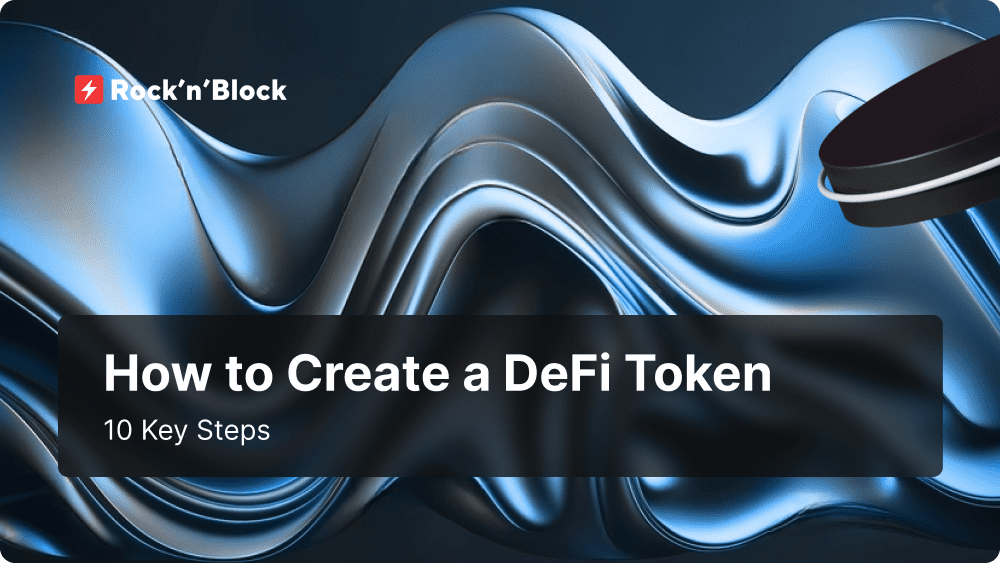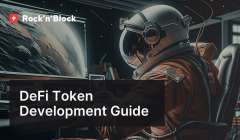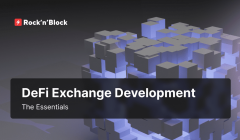How to Create a DeFi Token: 10 Key Steps
03 May 2024Token development process stands as a cornerstone for innovation, transforming traditional financial paradigms into decentralized, community-driven ecosystems. This article serves as a gateway into the intricacies of DeFi token development, offering insights and guidance for those seeking to navigate the complexities of this DeFi space.
From conceptualization to mainnet deployment, we will explore the key considerations, technical aspects, and community engagement strategies that underpin successful DeFi token development.

Table of Contents:
-
Overview of Decentralized Finance
-
Significance of DeFi Tokens in the Crypto Ecosystem
-
Step-by-Step Process of DeFi Token Development
-
1. Define the Purpose and Use Case
-
2. Plan Tokenomics
-
3. Smart Contract Development
-
4. Security Audits
-
5. Integration with DeFi Protocols
-
6. User Interface Development
-
7. Testing
-
8. Deployment to Mainnet
-
9. Community Engagement
-
10. Ongoing Maintenance and Upgrades
-
Conclusion
Overview of Decentralized Finance
Decentralized finance, or DeFi, is a revolutionary financial model that uses blockchain technology to establish an accessible and open financial ecosystem. Unlike traditional finance, which depends on central intermediaries like banks and brokers, DeFi operates on decentralized networks, primarily blockchain platforms such as Ethereum.
DeFi includes various financial services and applications, such as lending, borrowing, trading, yield farming, and governance, all executed through smart contracts. This innovative approach aims to remove traditional barriers to financial access, increase transparency, and give users greater control over their assets. DeFi has attracted considerable attention for its potential to redefine how financial services are used and utilized, promoting a more inclusive and democratic global financial system.
Significance of DeFi Tokens in the Crypto Ecosystem
DeFi tokens are essential to the cryptocurrency ecosystem as they power decentralized applications development. They allow users to participate in financial activities such as lending, trading, and governance within a decentralized framework. DeFi tokens development promotes financial inclusivity, eliminates intermediaries, and provides users with direct control over their assets. DeFi tokens not only serve a useful purpose, but also contribute to the overall liquidity and dynamism of the crypto space, shaping the future of decentralized finance.
DeFi Tokens vs. Traditional Finance
DeFi tokens development is challenging the traditional financial landscape by offering a decentralized, transparent and inclusive alternative. These tokens operate on blockchain platforms and enable peer-to-peer transactions through smart contracts, reducing the need for centralized intermediaries and promoting global financial accessibility.
This approach empowers the unbanked and underbanked by providing services such as lending and borrowing.
DeFi tokens are paving the way for a transformative and borderless financial future, reconsidering traditional finance's centralized control, barriers to entry, and limitations in financial inclusivity. Although regulatory and security challenges exist, a hybrid model that combines innovation with compliance for a more inclusive financial ecosystem may emerge from the coexistence of DeFi and traditional finance.
Make sure to learn DeFi Token Features in the Development Process!
Step-by-Step Process of DeFi Token Development
In this step-by-step guide, we navigate the intricate process of creating DeFi tokens, from shaping tokenomics and coding smart contracts to undergoing meticulous security audits and finally deploying your creation onto the blockchain.
1. Define the Purpose and Use Case
Embarking on the journey of DeFi token development requires meticulous planning to ensure its success and functionality within the decentralized finance ecosystem.
Explore DeFi Landscape
Gain a deep understanding of the current DeFi landscape. Identify the main challenges or inefficiencies that your token creation can address. Explore existing DeFi projects and analyze successful use cases to gain insights and inspiration.
Identify Objectives
It is important to clearly define the primary goals of your DeFi token. Identify whether it is designed for decentralized lending, yield farming, governance, or any other specific function. Knowing the purpose and use case of your token is essential for shaping its characteristics and usefulness.
Market Research
Conduct thorough market research to identify the needs and preferences of your target audience. Analyze existing DeFi projects to identify successful strategies and potential gaps in the market that your token could address. This research will help you to define your token's design and features.
Choosing the Right Token Standard
Evaluate different token standards (e.g., ERC-20, ERC-721) based on your token's use cases and functionalities. ERC-20 is commonly used for fungible tokens, while ERC-721 is ideal for NFT development. Decide which standard aligns best with your token's purpose.
2. Plan Tokenomics
Decentralized finance tokenomics, the economic model that governs the creation, distribution, and utility of tokens within a decentralized ecosystem, plays a pivotal role in the success and sustainability of a DeFi project development. Careful planning of tokenomics is a critical aspect of crypto token development, influencing everything from user engagement to the long-term viability of the project. Let's delve into the key aspects of planning tokenomics.
Token Supply
Decide on the total supply of your DeFi token. Consider whether it will have a fixed supply or a dynamic one, and determine the distribution of tokens across various stakeholders.
Distribution Model
Plan how your tokens will be distributed. Options include private sales, public sales, airdrops, or liquidity mining. Each distribution method has its advantages and implications for the token's initial and ongoing value.
Economic Models
Choose economic models that align with your token's purpose. Common models include yield farming, staking, and liquidity provision. These models incentivize user participation and contribute to the overall ecosystem.
3. Smart Contract Development
Smart contract development is the backbone of DeFi token creation, serving as the digital agreement that automates and enforces the rules and functionalities of a decentralized financial ecosystem. In the realm of decentralized finance, the role of smart contracts is multifaceted and crucial, influencing everything from token creation to user interactions. Let's explore the key aspects of smart contract development in DeFi token development.
Select Blockchain
Choose a blockchain that supports smart contracts. Ethereum is a popular choice, but you might also consider Binance Smart Chain, Solana, or other platforms based on your project's requirements.
Develop Smart Contracts
Create smart contracts that define the rules and functionalities of your DeFi token. This may include functions for minting, burning, transferring, and other actions. Thoroughly test these contracts to ensure their security and efficiency.
4. Security Audits
Security audits are a crucial and indispensable component of DeFi token development. In the ever-evolving landscape of decentralized finance, where security failures can have serious consequences, it is paramount to ensure the stability and robustness of a token's smart contracts.
Smart Contract Audits
Carefully conduct security audits on your smart contracts. These audits are essential for identifying vulnerabilities and weaknesses in the code. Fixing any issues found during the audit is crucial for maintaining the integrity and security of your DeFi token.
Front-End and Back-End Security
Audits go beyond smart contract code, evaluating the security of both front-end and back-end components. This complete approach helps prevent a range of potential attack vectors.
5. Integration with DeFi Protocols
Ensure that your token can seamlessly interact with existing DeFi protocols. Integration with decentralized exchanges (DEXs), lending platforms, or liquidity pools enhances the utility of your token and opens up opportunities for users.
Decentralized Exchanges (DEXs)
Integration with DEXs, such as Uniswap or SushiSwap, facilitates the trading of the DeFi token in a decentralized and permissionless manner. This enhances liquidity and allows users to seamlessly exchange the token without relying on a centralized intermediary.
Find out about the DeFi Exchange Development Essentials in our in-depth guide!
Lending Protocols
Integrating with lending protocols such as Aave or Compound enables users to lend their tokens and earn interest. Furthermore, borrowers can use the DeFi token as a guarantee to lend other assets, expanding its use cases within the lending ecosystem.
Yield Farming
DeFi tokens can be integrated into yield farming protocols, where users provide liquidity or stake their tokens to earn additional rewards. This motivates users to actively participate in the ecosystem, contributing to liquidity and stability.
6. User Interface Development
User Interface (UI) development is a critical aspect of creating a crypto token, as it directly impacts how users interact with the token and the associated decentralized finance ecosystem. A well-designed and intuitive UI enhances user experience, fosters adoption, and leads to the overall success of the project.
Key Aspects
Develop intuitive and user-friendly interfaces, such as web or mobile applications, to enable users to interact with your DeFi token easily. By prioritizing wallet integration, creating intuitive dashboards, enabling easy participation in DeFi activities, and maintaining a focus on user education and security, DeFi token developers can craft a UI that enhances the user experience and fosters trust within the decentralized finance ecosystem.
7. Testing
It involves deploying the token and associated smart contracts onto a testnet, which is a blockchain environment designed for testing and experimentation. This allows crypto token developers to assess the functionality, security, and performance of the DeFi token in a simulated environment before launching it on the mainnet.
Testnet Deployment
To conduct comprehensive testing in a simulated environment, deploy your DeFi token on a testnet. This phase will enable you to identify and fix any issues or bugs before launching on the mainnet.
8. Deployment to Mainnet
After deployment, the DeFi token is available to a global audience, allowing users to participate in various financial activities within the decentralized ecosystem. Successful deployment to the mainnet is a significant milestone, demonstrating a strong focus on transparency, security and the advancement of decentralized finance.
Choose Deployment Time
Schedule the deployment of the mainnet at a time that minimizes disruptions and aligns with the project's communication strategy. Take into account potential network traffic load and choose a time when user activity is expected to be lower.
Mainnet Launch
Once testing is successful, deploy your DeFi token on the mainnet. This marks the official launch and makes your token accessible to the broader community.
9. Community Engagement
Community engagement is a crucial aspect of DeFi token development, playing a pivotal role in building a strong and supportive user base. Effective community engagement fosters trust, encourages adoption, and contributes to the overall success of a DeFi project development.
Build a Community
Engage with the community through various channels, such as social media, forums, and dedicated communication platforms. Building a strong community is essential for user adoption, fostering trust, and obtaining valuable feedback.
Community Support Channels
Create dedicated channels for community support to quickly address user questions and concerns. This will enhance the overall user experience by providing fast and effective support.
10. Ongoing Maintenance and Upgrades
Ongoing maintenance and upgrades are essential components to create a token, ensuring that the DeFi token remains secure, functional, and aligned with the evolving needs of the community.
Regular Updates
Continuously monitor the performance and security of your DeFi token. Implement regular updates and improvements based on user feedback, changing market conditions, and technological advancements. Staying current ensures the long-term viability and relevance of your token.
Regular Feature Updates
Regularly upgrade the platform to introduce new features, enhance existing functionality and improve the overall user experience. Ensure clear communication of feature updates to the community.
In summary, a DeFi token development involves meticulous planning, technical expertise, and ongoing community engagement. Following these steps ensures that your token is not only technically strong but also aligned with market needs and regulatory requirements, contributing to the success of your decentralized finance project.
Conclusion
DeFi token development process requires careful consideration, strategic planning, and ongoing commitment. Each step, from conceptualization to deployment on the mainnet, plays a pivotal role in shaping the token's success within the dynamic landscape of decentralized finance. To navigate the complexities of DeFi token creation, crypto token developers should understand the particularities of decentralized finance, recognize the role of tokenomics, use strong smart contract development practices, prioritize security and user experience.
We ❤️ Development
Follow us on social media to receive the hottest blockchain development updates
Crunchbase ⚡️Twitter ⚡️Telegram⚡️LinkedIn⚡️Facebook⚡️Instagram⚡️Quora







